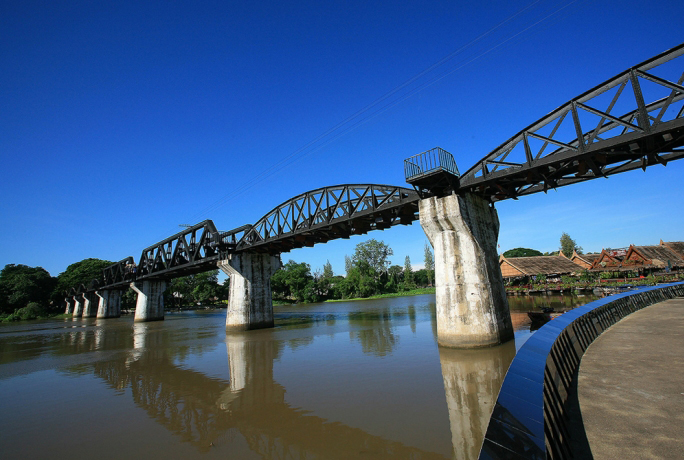- 16
- 6
- 9
- 2
- 1
- 1
- 3
- 5
- 4
- 1
- 6
- 1
- 4
- 5
- 5
- 4
- 7
- 3
- 4
- 4
- 2
Kanchanaburi
It is primarily the magnificent landscape and natural beauty that has made Kanchanaburi such a major tourist destination in Thailand; with numerous visitor, natural and cultural attractions including waterfalls, caves once inhabited by Neolithic man, well-cared for national parks, virgin forests and of course the rich heritage of Thailand that is preserved in the temples, museums and traditions of the area.
Many visitors come for the outdoor adventures like golfing, trekking, elephant rides, rafting, canoeing, mountain biking, bird-watching and the delights of the diverse wildlife of Kanchanaburi; for those seeking the cultural delights, the journey has plenty to reward. Kanchanaburi is a reflection of its past, when the Three Pagodas Pass, a break in the Thanon Thongchai Mountain Range that divides Thailand and Myanmar, was a primary trade route from India and the place where Buddhism is said to have first come to Thailand around the 3rd century.
Relics, architecture, customs, cuisine and dialects are today’s evidence of when the province and its pass were under various influences, like the Khmer of Angkor in the 13th century; the Khmer temple dates from this time and is a well known attraction for visitors to the area. From the military garrison built by the kingdom of Ayutthaya that was later passed through by the Burmese who eventually destroyed the capital of Ayutthaya, to the railway built by the Japanese using POWs in World War II that became known as the ‘Death Railway’ and included the infamous bridge crossing the Kwai River, Kanchanaburi has tales to tell.
The area is also home to numerous hill tribes who accept visitors and are delighted to share their traditional ways and the city of Kanchanaburi itself, located at the point where the Khwae Noi and Khwae Yai Rivers meet and form the Maenam Mae Klong, is also known for the warmth of its welcome and the way it honours its past. The sights, sounds, stories and ways of the ancestors are preserved and shared through each generation and in Kanchanaburi, folk music and dances dating back over 500 years are still regularly performed today.

- Jan
- Feb
- Mar
- Apr
- May
- Jun
- Jul
- Aug
- Sep
- Oct
- Nov
- Dec
